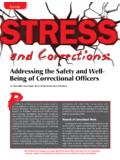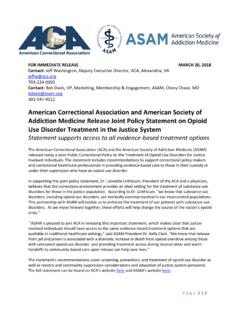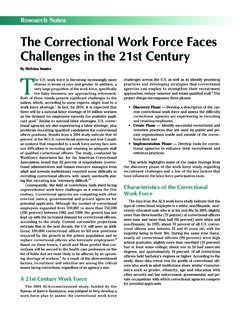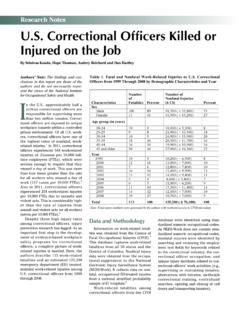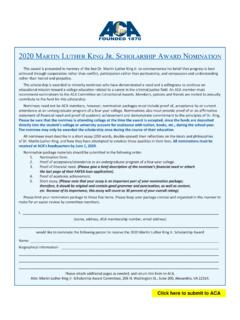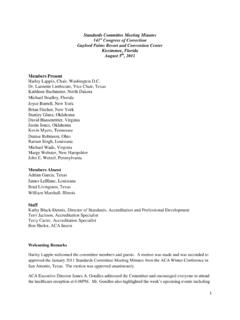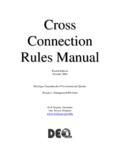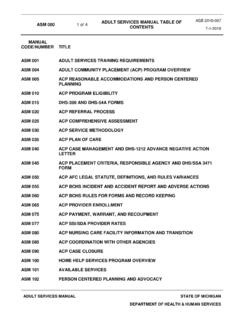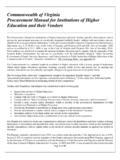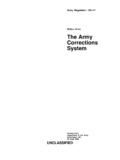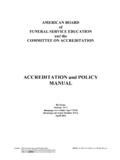Transcription of APM - 1 - ACA
1 APM - 1 american correctional association Manual of Accreditation Policy and Procedure APM-1 March 15, 2017 APM - 1 March 15, 2017 2 FORWARD Perhaps one of the american correctional association s greatest contributions to the field of corrections has been the development of a national accreditation process. ACA performance standards and expected practices address services, programs, and operations essential to effective correctional management. Through accreditation, an agency is able to provide an environment that safeguards the life, health, and safety of the public, staff and offenders while at the same time providing the necessary education, work, religious, and rehabilitative opportunities that enable an offender to prepare for successful reintegration into the community. Performance standards and expected practices set by ACA reflect best practices and current relevant policies and procedures and function as a management tool for over 1,500 correctional agencies in the United States.
2 This Accreditation Policy Manual is offered as a foundation of policy and procedure that will enable correctional programs to achieve their goals of providing the highest levels of effectiveness and efficiency while accomplishing proven and meaningful positive outcomes. It will provide guidance to participating programs, field auditors, and other interested parties. I would like to take this opportunity to express my sincere appreciation to all who participated in its development. A very special thank you to Past-President Livers, President Linthicum, Standards and Accreditation Assessment Project Chair Secretary James M. Le Blanc, Past President Richard L. Stalder, and Angela Whittaker for their commitment to excellence and unwavering dedication to ACA s mission. We hope you find that this manual enhances the accreditation process while balancing the goals of integrity, consistency, excellence and most importantly achievability.
3 Together we will further enhance and promote the integrity of our accreditation process and support corrections as an important profession and a bedrock of our democracy. James A. Gondles Jr, CAE APM - 1 March 15, 2017 3 Table of Contents I. Overview of the american correctional association ..6 II. Organizational Purposes of the american correctional association .. 7 III. Overview of the Commission on Accreditation for Corrections ..8 IV. The Accreditation Process ..9 Performance Based Standards & Expected Practices Accreditation Department ..10 Performance Based Accreditation Model Accountability ..14 Confidentiality ..15 Eligibility Criteria .. 15 Application Process ..16 Selecting the Appropriate Accreditation Manual ..17 Fees ..17 Agency Withdrawal ..17 V. The Pre-Audit Process ..18 Agency Organization and Activities ..18 The Accreditation Manager ..18 Orientation for Agency Personnel.
4 19 The Work Plan ..19 Performance Based Outcome Measures ..20 Significant Incident Summary ..21 VI. Developing Documentation ..22 Setting up Files ..23 Compliance Protocols ..23 Process Indicators ..24 Application of Revised Expected Practices ..24 Non-applicable Expected APM - 1 March 15, 2017 4 VII. Technical Assistance ..26 Mock VIII. The Self-Evaluation Report ..28 Compliance Tally ..28 Submission of the Self-Evaluation Report ..28 IX. The Audit Process ..29 Audit Request and Arrangements ..29 Final Agency Preparation ..29 The Visiting Committee ..30 X. Conduct of the Compliance Audit ..32 Entrance Interview ..33 Agency Tour ..33 Compliance Review ..34 Interviews ..36 Daily Out Briefing ..36 Exit Audits of Probation and Parole Agencies ..37 Initial Accreditation and/or Re-Audit Options ..38 XI. The Visiting Committee Report ..39 Report Elements ..39 Non-compliant Expected Practices.
5 40 Waivers ..41 Appeals ..42 Expected Practice Compliance Processing Chart ..43 XII. Accreditation Hearings ..44 Conduct of Hearings ..44 Accreditation Decisions ..46 Appeal Process ..47 XIII. Accredited Status ..48 Annual Report ..48 Critical Incident Monitoring Visits ..49 Revocation of Accreditation ..50 Expiration of Accredited Status ..50 XIV. Reaccreditation ..51 Eligibility ..51 Activities ..51 Compliance Reaccreditation Audit ..51 Visiting Committee Report ..52 Accreditation Hearing ..52 APM - 1 March 15, 2017 5 XV. Visiting Committee Roles and Responsibilities ..53 A. Auditor Code of Ethics ..53 B. Auditor Training ..53 C. Auditor Preparations ..55 D. Visiting Committee Role and Responsibilities ..57 E. Conduct of Compliance Audit ..60 F. Visiting Committee Report ..70 G. Specialized Audits and Consulting Visits ..74 H. Audit Reminders ..81 XVI. ACA Awards Program ..83 Appendices Appendix A - Compliance File Documentation Appendix B - Notice of Application for Accreditation.
6 87 Appendixes C 1 - 3 - Organization Summaries ..88 Appendix D - Compliance Checklist ..96 Appendix E - Compliance Tally ..97 Appendix F - Response to Non-compliance ..98 Appendix G - Significant Incident Summary ..100 Appendix H - Critical Incident Summary Form ..102 Appendix I - Annual Report ..104 Appendix J Visiting Committee Member Evaluation ..107 Glossary .. Supplemental Document APM - 1 March 15, 2017 6 I. Overview of the american correctional association The american correctional association (ACA) is a professional membership organization composed of individuals, agencies and organizations involved in all facets of the corrections field, including adult and juvenile services, community corrections, probation and parole and jails. It has thousands of members in the United States, Canada and other nations, as well as over 100 chapters and affiliates representing states, professional specialties, or university criminal justice programs.
7 For more than 145 years, ACA has been the driving force in establishing national correctional policies and advocating safe, humane and effective correctional operations. Today, ACA is the world-wide authority on correctional policy and standards, disseminating the latest information and advances to members, policymakers, individual correctional workers and departments of correction . ACA was founded in 1870 as the National Prison association and became the american Prison association in 1907. At its first meeting in Cincinnati, the assembly elected Rutherford B. Hayes, then governor of Ohio and later president, as the first president of the association . At that same meeting, a Declaration of Principles was developed, which became the accepted guidelines for corrections in the United States and Europe. At the 1954 annual Congress of correction in Philadelphia, the name of the american Prison association was changed to the american correctional association , reflecting the changing philosophy of corrections and its increasingly important role in society.
8 Since that time, ACA has continued to take a leadership role in corrections and work toward a professional unified voice in correctional policy. In recent years, one of the association s major goals has been the development of national and international policies and resolutions of significant issues in corrections. Policies are considered for ratification at the association s two annual conferences and ratified policies are then widely disseminated. Since its formation, ACA has also had a major role in designing professional standards, and more recently performance based standards and expected practices, for correctional organizations. Since the early 1980s ACA has been involved in a program of accreditation to recognize programs representing excellence in more than 20 different disciplines within the field, with emphasis on evidenced based practices. The association conducts research and evaluation activities, provides training and technical assistance, and carries out the regular responsibilities of any professional membership organization, including a full publications program.
9 The association s two annual conferences, held in varying cities across the nation, includes the participation of delegates and correctional practitioners from the 50 states, territories, and several foreign countries. Membership in ACA is open to any individual, agency, or organization interested in corrections and the purposes and objectives of the association . Members include the majority of state, local, provincial, and territorial correctional agencies, individual correctional institutions, local jails, pretrial programs and agencies, juvenile justice programs, schools of criminal justice in colleges and universities, libraries, and various probation, parole, and correctional agencies. Many of ACA s members are employed at federal, military, private, state, and local agencies. Members also include volunteers affiliated with these agencies as service providers or as members of advisory boards and committees.
10 APM - 1 March 15, 2017 7 II. Organizational Purposes of the american correctional association Among the most significant purposes of the association as outlined in its Constitution, are: To provide a professional association of persons, agencies, and organizations, both public and private, who hold in common the goal of improving the profession of corrections and enhancing their contribution to that profession. To broaden and strengthen support for the association s goals by advocating association policies, resolutions, positions, and standards to policymakers and the public and by forming coalitions with other professional organizations sharing these goals. To develop standards for all areas of corrections and implement a system for accreditation for correctional programs, facilities and agencies based on these standards. Where feasible, standards shall be based on performance outcome.
